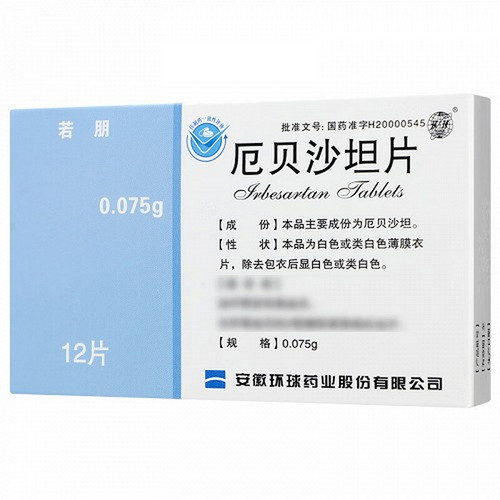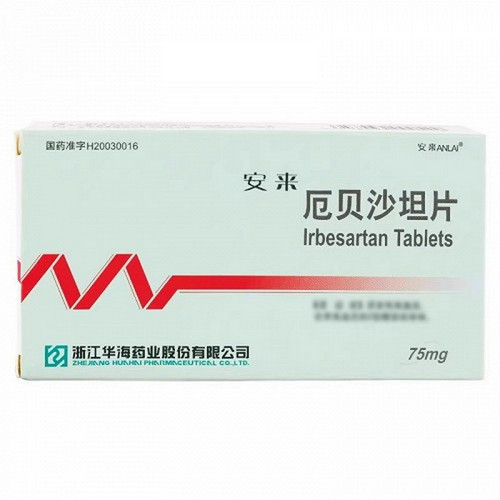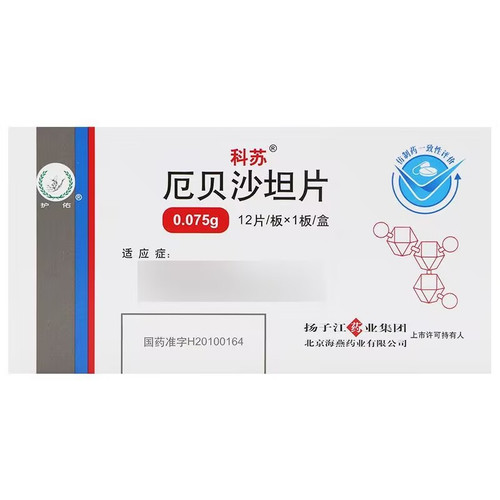Product Overview
[Drug Name]
Generic Name: Irbesartan Tablets
Trade Name: Zhenshengyuan Irbesartan Tablets 75mg*30 Tablets
Pinyin Full Code: ZhenShengYuan EBeiShaTanPian 75mg*30 Tablets
[Main Ingredient]
Chemical Name: The main ingredient of this product is irbesartan, which is chemically known as 2-butyl-3-{4-[2-(1H-tetrazol-5-yl)phenyl]benzyl]-1,3-diazaspiro-{4,4]wang-1-en-4-one. Molecular Formula: C25H28N6O Molecular Weight: 428.54
[Properties]
This product is a white or off-white film-coated tablet. After removing the coating, it appears white or off-white.
[Indications/Main Functions]
Treatment of essential hypertension. Treatment of type 2 diabetic nephropathy associated with hypertension.
[Specifications]
75mg * 30 tablets
[Dosage and Administration]
The recommended initial and maintenance dose is 150mg daily. Dietary considerations have no impact on medication administration. Generally, 150mg of irbesartan once daily provides better 24-hour blood pressure control than 75mg. However, for certain patients, particularly those undergoing hemodialysis and those over 75 years of age, a 75mg initial dose may be considered. For patients whose blood pressure is not effectively controlled with 150mg of irbesartan once daily, the dose can be increased to 300mg or other antihypertensive medications can be added. In particular, the addition of diuretics such as hydrochlorothiazide has been shown to have an additive effect. For hypertensive patients with type 2 diabetes, the initial treatment dose should be 150mg once daily, increasing to 300mg once daily as a maintenance dose for kidney disease. Clinical studies have demonstrated that irbesartan benefits the kidneys in hypertensive patients with type 2 diabetes. In studies, irbesartan has been used in combination with other antihypertensive medications, as needed, to lower blood pressure to target values. Renal Impairment: No dose adjustment is required for patients with renal impairment, but a lower initial dose (75 mg) may be considered for patients undergoing hemodialysis. Volume Depletion: Patients with volume and/or sodium depletion should correct this before using this product. Hepatic Impairment: No dose adjustment is required for patients with mild to moderate hepatic impairment. There is currently no clinical experience in patients with severe hepatic impairment. Elderly Patients: Although a starting dose of 75 mg may be considered for patients over 75 years of age, no dose adjustment is generally required for elderly patients. Pediatric Patients: The safety and efficacy of irbesartan tablets in children have not been established.
[Adverse Reactions]
The incidence of the adverse reactions listed below is defined as follows: very common (1/10); common (1/100); uncommon (1/1000, 1/100); rare (1/10,000, 1/1000); and very rare (1/10,000). For Hypertension: In placebo-controlled trials in patients with hypertension, the overall incidence of adverse events did not differ between the irbesartan group (56.2%) and the placebo group (56.5%). Discontinuation of treatment due to clinical or laboratory adverse events was less frequent in the irbesartan group (3.3%) than in the placebo group (4.5%). Adverse events were not related to dose (within the recommended dose range), sex, age, race, or treatment duration. In placebo-controlled trials, 1,965 patients received irbesartan, and the following adverse drug reactions were reported: Neurological disorders: Common: Dizziness; Occasional: Postural dizziness; Cardiac disorders: Occasional: Tachycardia, edema; Vascular disorders: Occasional: Flushing Respiratory, Chest, and Diaphragmatic Disorders: Uncommon: Cough. Gastrointestinal Disorders: Common: Nausea and vomiting. Occasional: Diarrhea, dyspepsia, heartburn. Reproductive and Breast Disorders: Uncommon: Sexual Dysfunction. Systemic Disorders and Administration Conditions: Common: Fatigue. Occasional: Chest pain. Examination: Common: Significant increases in plasma creatine kinase levels (1.7%) were commonly observed in the irbesartan-treated group. However, none of these increases were associated with clinically recognizable skeletal muscle events. For Hypertension and Type 2 Diabetes with Renal Disease: In addition to the adverse drug reactions mentioned under hypertension, postural dizziness and orthostatic hypotension were reported in 0.5% (i.e., infrequently) of diabetic hypertensive patients with microalbuminuria and normal renal function, exceeding the placebo group. The following adverse reactions were reported in 2% of diabetic hypertensive patients with chronic renal insufficiency and significant proteinuria, exceeding the placebo group. Nervous System Disorders: Very Common: Dizziness. Common: Postural dizziness. Vascular Abnormalities: Common: Orthostatic Hypotension Skeletal Muscle, Connective Tissue, and Bone Abnormalities: Common: Skeletal Muscle Pain Examination: Hyperkalemia occurred more frequently in diabetic patients treated with irbesartan than in those treated with placebo. Among diabetic hypertensive patients with microalbuminuria and normal renal function, hyperkalemia (5.5 mEq/L) occurred in 29.4% of patients treated with irbesartan 300 mg (very common), compared with 22% of patients treated with placebo. Among diabetic hypertensive patients with chronic renal insufficiency and significant proteinuria, hyperkalemia (5.5 mEq/L) occurred in 46.3% of patients treated with irbesartan 300 mg (very common), compared with 26.3% of patients treated with placebo. Progressive diabetic nephropathy associated with treatment. A decrease in hemoglobin (hemoglobin) was reported in 1.7% of hypertensive patients (common), but this was not clinically significant. In addition, the following adverse reactions have been reported since the launch of irbesartan:Immune system disorders: Very rare: As with other angiotensin-1 receptor antagonists, a small number of cases have reported hypersensitivity reactions such as rash, urticaria, and angioedema. Metabolic and nutritional disorders: Hyperkalemia. Neurological disorders: Headache, vertigo. Ear and labyrinthine disorders: Tinnitus. Gastrointestinal disorders: Anorexia. Hepatobiliary disorders: Elevated liver enzymes, hepatitis, jaundice. Skeletal muscle, connective tissue, and bone disorders: Myalgia, arthralgia. Renal and urinary tract disorders: Renal impairment, including isolated cases of renal failure in at-risk patients. Systemic disorders: Asthenia.
[Contraindicated Contraindications]
Known allergies to any of the ingredients in this product. Pregnancy during the fourth to ninth month. Lactation. Patients with diabetes or moderate to severe renal impairment (GFR less than 60 mI/min/1.73 m²) should not use this product in combination with aliskiren. Patients with diabetic nephropathy should not use this product in combination with angiotensin-converting enzyme inhibitors (ACEIs).
[Precautions]
Dual blockade of the renin-angiotensin-aldosterone system (RAAS): Dual blockade of the RAAS increases the risk of hypotension, hyperkalemia, and renal dysfunction compared to single-agent therapy. Therefore, concomitant use of this drug with angiotensin-converting enzyme inhibitors (ACEIs) or aliskiren is not recommended. Concomitant use of this drug with aliskiren is contraindicated in patients with diabetes or moderate to severe renal impairment (GFR less than 60 ml/min/1.73 m²). This drug should not be used in combination with angiotensin-converting enzyme inhibitors (ACEIs) in patients with diabetic nephropathy. General Precautions: In patients whose vascular tone and renal function depend primarily on the activity of the renin-angiotensin-aldosterone system (such as those with severe congestive heart failure or renal disease, including renal artery stenosis), treatment with ACE inhibitors or angiotensin II receptor antagonists that affect this system has been associated with acute hypotension, azotemia, oliguria, or, rarely, acute renal failure. As with any antihypertensive medication, excessive blood pressure reduction in patients with ischemic cardiomyopathy or ischemic cardiovascular disease may result in myocardial infarction or stroke. Fetal/Neonatal Morbidity and Mortality: Although there is no experience with the use of this medication in pregnant women, in utero exposure to ACE inhibitors during the second and third trimesters has been reported to result in harm and mortality to the developing fetus. Therefore, like any medication that directly acts on the renin-angiotensin-aldosterone system, this medication should not be used during pregnancy. If pregnancy is discovered during treatment, this medication must be discontinued as soon as possible. Hypotension/Volume Depletion: This medication rarely causes hypotension in hypertensive patients without other comorbidities. Similar to ACE inhibitors, symptomatic hypotension may occur in patients with sodium depletion/volume depletion, such as those receiving high-dose diuretics and/or salt restriction or hemodialysis. Before initiating irbesartan therapy, volume depletion and/or sodium depletion must be corrected or a lower starting dose should be considered. Renovascular Hypertension: Patients with bilateral renal artery stenosis or stenosis of the artery to a single functioning kidney are at increased risk of severe hypotension and renal insufficiency when using drugs that affect the renin-angiotensin-aldosterone system. Increases in serum creatinine and/or blood urea nitrogen have been reported. Although there is no experience with the use of irbesartan in patients with unilateral or bilateral renal artery stenosis, similar effects of angiotensin receptor blockers should be considered. Renal Impairment and Kidney Transplantation: When irbesartan is used in patients with renal impairment, regular monitoring of serum potassium and creatinine is recommended. There is no experience with the use of irbesartan in patients with recent renal transplantation. Hypertensive Patients with Type 2 Diabetes and Kidney Disease: Analyses of studies in patients with advanced renal disease have shown inconsistent effects of irbesartan on renal and cardiovascular events across all subgroups. In particular, the drug appears to be less beneficial in women and non-white populations. Hyperkalemia: As with other drugs that affect the renin-angiotensin-aldosterone system, hyperkalemia may occur with the use of this drug, particularly in patients with renal impairment, significant proteinuria due to diabetic nephropathy, and/or heart failure. Close monitoring of serum potassium levels is recommended in these patients. Lithium: Concomitant use of this drug with lithium is not recommended. Aortic and mitral stenosis, hypertrophic obstructive cardiomyopathy: As with other vasodilators, caution should be exercised when using this drug in patients with aortic and mitral stenosis and hypertrophic obstructive cardiomyopathy. Primary aldosteronism: Patients with primary aldosteronism generally do not respond to antihypertensive drugs that inhibit the renin-angiotensin system. Therefore, this drug is not recommended for these patients. Race: As with angiotensin-converting enzyme inhibitors, irbesartan and other angiotensin antagonists are significantly less effective in lowering blood pressure in blacks than in non-blacks, possibly due to the higher prevalence of low renin levels in hypertensive patients in blacks. Effects on the ability to drive and use machines: The effects of irbesartan on the ability to drive and use machines have not been studied, but based on its pharmacodynamic properties, irbesartan is unlikely to affect these abilities. Occasional dizziness or fatigue during treatment of hypertension should be considered when driving or using machines.






